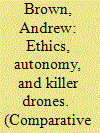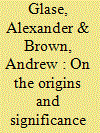| Srl | Item |
| 1 |
ID:
069202


|
|
|
| 2 |
ID:
193544


|
|
|
|
|
| Summary/Abstract |
As technology advances, machines will increasingly serve as moral arbiters of difficult and convoluted war tasks. Humanity is already in the dawn of the “Autonomous Revolution” and ethical questions and considerations regarding the use of artificial intelligence (AI) in war cannot be delayed. The use of AI-enabled weaponized drones is a microcosm of the issues that arise. The purpose of this paper is to create and sustain a discussion of the ethics of emerging defense technologies by considering them in the context of mainstream ethical frameworks, analyzing the U.S.’s decision-making and moral justifications to date, and discussing what ethics should be instilled in AI-enabled military drones themselves, if indeed the U.S. decides to further pursue them.
|
|
|
|
|
|
|
|
|
|
|
|
|
|
|
|
| 3 |
ID:
149609


|
|
|
|
|
| Summary/Abstract |
The International Atomic Energy Agency (IAEA) defines uranium with a 235U isotope concentration of 20 percent as the threshold between low-enriched uranium (LEU) and highly enriched uranium (HEU), and as a significant waypoint on the path towards weapon-grade uranium (typically above 90 percent 235U enrichment). The distinction between LEU and HEU is widely used in shaping nonproliferation policy, and it has featured prominently in commentary over Iran's nuclear program and the series of Nuclear Security Summits that since 2010 have sought to minimize civilian stockpiles and use of HEU. Yet the origin of this threshold is obscure, dating back 6 decades. This research note traces the political origin and the technical basis for this limit.
|
|
|
|
|
|
|
|
|
|
|
|
|
|
|
|
| 4 |
ID:
099798


|
|
|
|
|
| Publication |
2010.
|
| Summary/Abstract |
From 1945 to 1949 the USA was the world's only nuclear power. Although the nuclear arsenal was overestimated both in terms of size and readiness by the US military in its war plans, atom bombs came to be seen as the essential counter to conventional Soviet forces. The USSR constructed its own bombs in turn, and for decades the analysis of nuclear deterrence was almost exclusively concerned with the two superpowers. In the twenty-first century, the nuclear world no longer displays that mirror-image symmetry and can now be viewed as unipolar, regional, multipolar or stateless. Nuclear deterrence that seemed such an established technical reality during the Cold War should be recognized as a psychological construct that depends on threat perception and cultural attitudes, as well as the values, rationality and strength of political leaders who themselves have to mediate between groups with vested economic or military interests. As the number of nuclear weapons states increases, the logic of nuclear deterrence becomes less obvious and it should not be casually invoked as a general security factor without regard to a specific context. Nuclear weapons have become emblems of geopolitical power under the guise of deterrence. We argue that nuclear deterrence is meaningless against extremist terrorists. Our survey of its quirks leads us to believe that nuclear deterrence is a far less foolproof and reliable global security mechanism than many assume.
|
|
|
|
|
|
|
|
|
|
|
|
|
|
|
|
| 5 |
ID:
193529


|
|
|
|
|
| Summary/Abstract |
Forecasts about how terrorists will utilize emerging technologies often outstrip the materialization of actual threats. The concern is not which technologies terrorists can access, but rather which will prove transformative to the terrorist cause, as the Internet has. These forecasts can be bettered through the application of an adoption model and the concept of proof of practicality. Utilizing these conceptualizations, it is possible to assess if and how emerging and increasingly commercialized technologies like 3D printing, commercial drones, and synthetic biology may be utilized by terrorist organizations both now and in the future.
|
|
|
|
|
|
|
|
|
|
|
|
|
|
|
|
| 6 |
ID:
088572


|
|
|
|
|
| Publication |
2009.
|
| Summary/Abstract |
Recently declassified materials have revealed the existence of a previously unknown network of Austrian communists in pre-war England. The group of young well-educated Viennese used unsuspecting social contacts and marriages of convenience to establish itself. Analysis of this network reveals some previously overlooked similarities between the 'Cambridge' spies Kim Philby and Alan Nunn May, as well as the emergence of a new nuclear spy, Engelbert Broda. Their wartime espionage as individuals took place at a time when non-communist British scientists were promoting the international sharing of atomic knowledge through unofficial channels. The newly released files reflect a characteristic preference of the British secret services for intelligence gathering rather than intervention and illustrate how vital leads follow from apparently trivial observations.
|
|
|
|
|
|
|
|
|
|
|
|
|
|
|
|